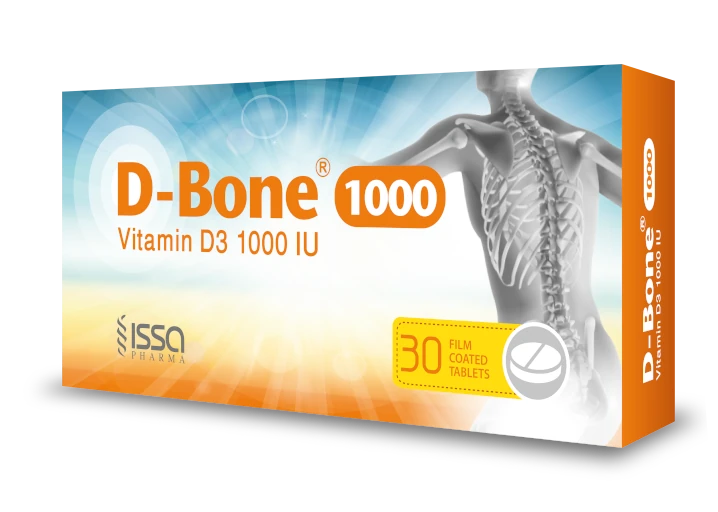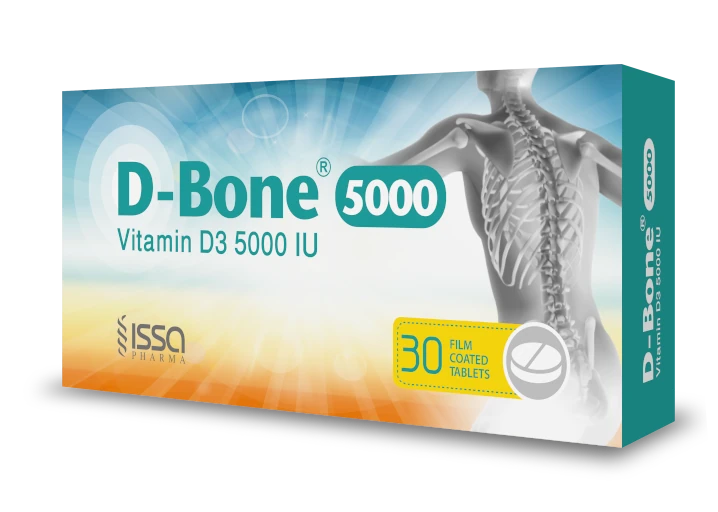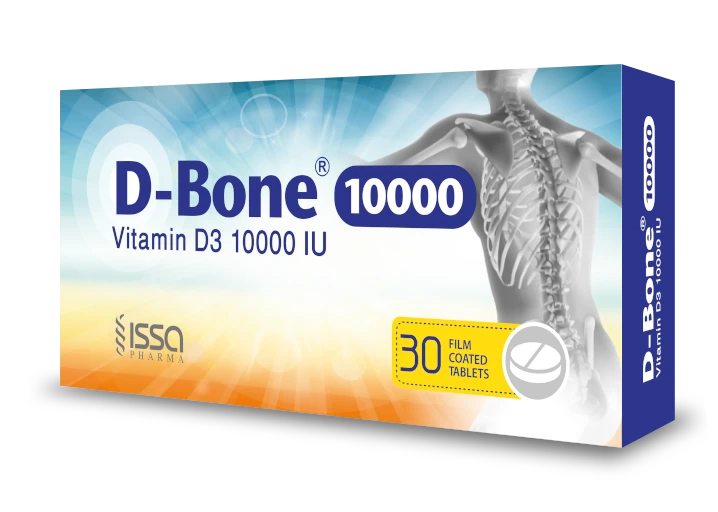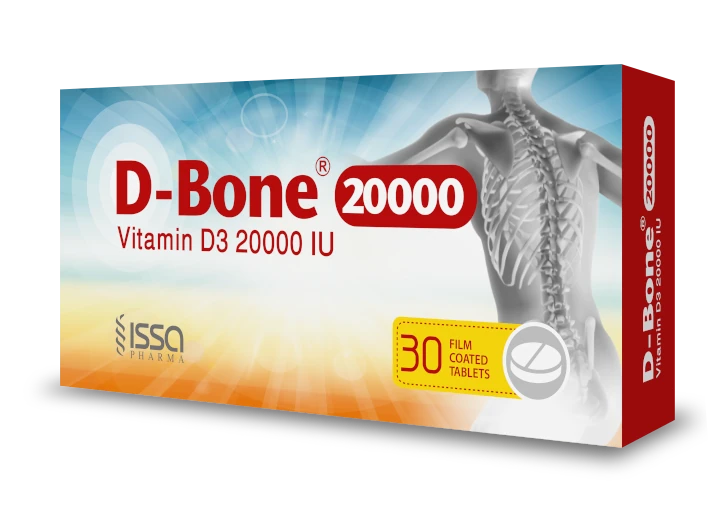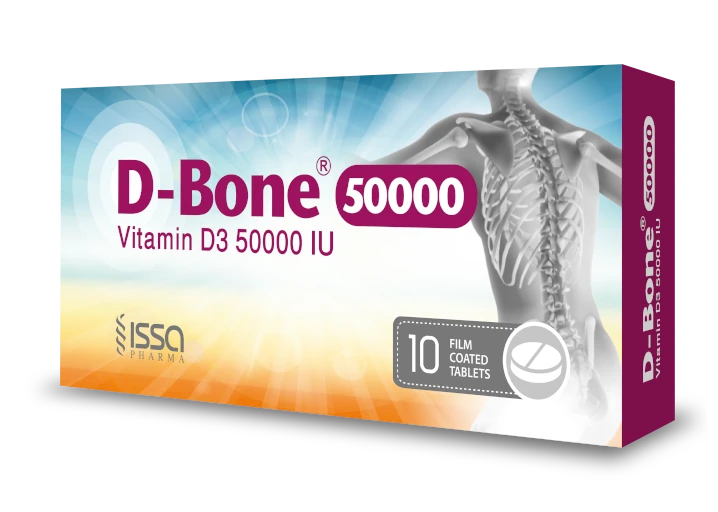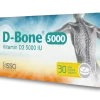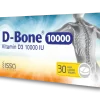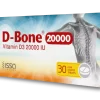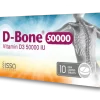COMPOSITION AND EXCIPIENTS
Active ingredient:
- Each film coated tablet of D-Bone 1,000 contains Vitamin D3 (as Cholecalciferol) 1,000 IU.
- Each film coated tablet of D-Bone 5,000 contains Vitamin D3 (as Cholecalciferol) 5,000 IU.
- Each film coated tablet of D-Bone 10,000 contains Vitamin D3 (as Cholecalciferol) 10,000 IU.
- Each film coated tablet of D-Bone 20,000 contains Vitamin D3 (as Cholecalciferol) 20,000 IU.
- Each film coated tablet of D-Bone 50,000 contains Vitamin D3 (as Cholecalciferol) 50,000 IU.
Excipients:
Modified Starch, Sucrose, Tocopherol, Sodium Ascorbate, Lactose Monohydrate, Sodium Starch Glycollate, Microcrystalline Cellulose, Croscarmellose Sodium, Colloidal Anhydrous Silica, Stearic Acid, Magnesium Stearate, HydroxypropylMethylcellulose, Titanium dioxide, Carnauba Wax, Talc, Iron oxide Yellow (For 5,000 IU), D&C Blue (For 10,000 IU), FD&C Green (For 20,000 IU), Iron Oxide Red (For 50,000 IU).
PHARMACODYNAMIC PROPERTIES
Absorption:
Colecalciferol is easily absorbed in the small intestine.
Colecalciferol is produced within the skin under the influence of UV radiation including sunlight. In its biologically active form, Colecalciferol stimulates intestinal calcium absorption, incorporation of calcium into the osteoid, and release of calcium from bone tissue. In the small intestine it promotes rapid and delayed calcium uptake. The passive and active transport of phosphate is also stimulated. In the kidney, it inhibits the excretion of calcium and phosphate by promoting
tubular resorption. The production of parathyroid hormone (PTH) in the parathyroids is inhibited directly by the biologically active form of Colecalciferol. PTH secretion is inhibited additionally by the increased calcium uptake in the small intestine under the influence of biologically active Colecalciferol.
Elimination:
Coleclaciferol and other forms of vitamin D are excreted in faeces and urine.
PHARMACOKINETICS
After a single oral dose of Colecalciferol, the maximum serum concentrations of the primary storage form are reached after approximately 7 days. 25(OH) D3 is then slowly eliminated with an apparent half-life in serum of about 50 days.
Colecalciferol and its metabolites are excreted mainly in the bile and faeces.
After high doses of Colecalciferol, serum concentrations of 25(OH) D3 may be increased for months. Overdose induced hypercalcaemia may persist for weeks.
INDICATIONS
- The treatment and prevention of vitamin D deficiency.
- As an adjunct to specific therapy for osteoporosis in patients with vitamin D deficiency or at risk of vitamin D insufficiency. Vit- D is indicated in adolescents and adults.
CONTRAINDICATIONS
D-Vit tablets must not be used in patients with:
Hypersensitivity to the active substance (Colecalciferol) or to any of the excipients.
Hypercalcaemia and/or hypercalciuria.
Nephrolithiasis / Renal calculi.
Hypervitaminosis.
Severe renal impairment.
UNDESIRABLE EFFECTS
Uncommon:
Hypercalcaemia and hypercalciuria.
Rare:
Pruritus, rash and urticaria.
WARNINGS AND PRECAUTIONS
D-Vit tablets should be used with caution in patients with impairment of renal function and the effect on calcium and phosphate levels should be monitored. The risk of soft tissue calcification should be taken into account. In patients with severe renal insufficiency, vitamin D in the form of Colecalciferol is not metabolised normally and other forms of vitamin D should be used.
D-Vit should not be taken by patients with a tendency to form calcium containing renal calculi.
Caution is required in patients receiving treatment for cardiovascular disease cardiac glycosides (including digitalis).
D-Vit should be prescribed with caution to patients suffering from sarcoidosis because of the risk of increased metabolism of vitamin D to its active form. These patients should be monitored with regard to the calcium content in serum and urine.
Allowances should be made for vitamin D supplements, other vitamin D containing medicines or from other sources. The need for additional calcium supplementation should be considered for individual patients. Calcium supplements should be given under close medical supervision prevent hypercalcaemia.
Paediatric population: D-Vit should not be given to infants and children under the age of 12.
DRUG INTERACTIONS
Phosphate infusions should not be administered to lower hypercalcaemia of hypervitaminosis D because of the dangers of metastatic calcification.
Patients treated with cardiac glycosides may be susceptible to high calcium levels and should have ECG parameters and calcium levels monitored. It is recommended to reduce the dose or interrupt treatment if the calcium content in the urine exceeds 7.5 mmol/24 hours (300 mg/24 hours).
Simultaneous administration of benzothiadiazine derivatives (thiazide diuretics) increases the risk of hypercalcaemia because they decrease the calcium excretion in the urine. The calcium levels in plasma and urine should therefore be monitored for patients undergoing long-term treatment.
If Colecalciferol is combined with metabolites or analogues of vitamin D careful monitoring of serum calcium levels is recommended.
Anti-convulsants e.g. phenytoin, phenobarbital, primidone may diminish the effect of Colecalciferol due to hepatic enzyme induction.
Rifampicin may reduce the effectiveness of Colecalciferol due to hepatic enzyme induction.
Isoniazid may reduce the effectiveness of Colecalciferol due to inhibition of the metabolic activation of Colecalciferol.
Drugs leading to fat malabsorption, e.g. orlistat, liquid paraffin, cholestyramine, may impair the absorption of Colecalciferol.
The cytotoxic agent actinomycin and imidazole antifungal agents interfere with vitamin D activity by inhibiting the conversion of 25-hydroxyvitamin D to 1,25-dihydroxyvitamin D by the kidney enzyme, 25-hydroxyvitamin D-1-hydroxylase.
Concomitant use of glucocorticoids can decrease the effect of vitamin D.
Effects on ability to drive and use machines:
No studies on the effects on the ability to drive or use machines have been performed. Colecalciferol has no known side effects that are likely to affect the ability to drive and use or operate machines.
Pregnancy:
Vitamin D3 should not be used during pregnancy unless the clinical condition of the woman requires treatment with colecalciferol, at a dose necessary to overcome the deficiency.
During pregnancy women should follow the advice of their medical practitioner as their requirements may vary depending on the severity of their disease and their response to treatment.
Based on human experience and animal studies, vitamin D overdose causes physical and mental disability and congenital heart and eye conditions, due to hypercalcaemia, when administered during pregnancy.
Breast-feeding:
Colecalciferol and its metabolites are excreted in breast milk. Overdose in infants induced by nursing mothers has not been observed. However, when prescribing additional vitamin D to a breast-fed child the practitioner should consider the dose of any additional vitamin D given to the mother.
DOSAGE AND ADMINISTRATIONS
Adult:
Vit D – 1,000:
Treatment of vitamin D deficiency: 1- 4 tablets (1,000- 4,000 IU) daily for 10 weeks dependent upon the severity of the disease and the patient’s response to treatment, followed by maintenance therapy of 1-2 tablets (1,000- 2,000 IU) daily, as directed by your doctor.
Follow-up serum 25(OH) D measurements should be made approximately three to four months after initiating maintenance therapy to confirm that the target level has been achieved.
Prevention of vitamin D deficiency or treatment of vitamin D insufficiency: 1-2 tablets (1,000- 2,000 IU) daily.
Vit D – 20,000:
Treatment of vitamin D deficiency: 40,000 IU every week.
(2 tablets) for 7 weeks, followed by maintenance therapy (equivalent to 1400 – 2000 IU/day, i.e: 23 tablets per month, as directed by your doctor.
Follow up 25(OH) D measurements should be made approximately three to four months after initiating maintenance Therapy to confirm that the target level has been achieved.
Prevention of vitamin D deficiency: 20,000 IU every 4 weeks (1 tablet).
Higher doses may be required in certain Populations, see below:
Institutionalised or hospitalised individuals.
Dark skinned individuals.
Individuals with limited effective sun exposure due to protective clothing or consistent use of sun screens.
Patients being evaluated for osteoporosis.
Obese individuals.
Use of certain concomitant medications (e.g. anticonvulsant medications glucocorticoids, anti-retrovirals).
Those recently treated for vitamin D deficiency, and requiring maintenance therapy.
Patients with liver or renal disease.
Patients with malabsorption, including inflammatory bowel disease and coeliac disease.
As an adjunct to specific therapy for osteoporosis: 1 tablet (1,000 IU) daily.
Vit D – 5,000 :1 tablet daily or weekly.
Vit D – 10,000 :1 tablet weekly or as advised by your doctor.
Vit D – 50,000 :1 tablet weekly or as advised by your doctor.
Adolescent Posology (over 12 years):
Treatment of vitamin D deficiency or insufficiency in children over 12 years: 1 tablet (1,000 IU) daily depending on the severity of the disease and the patient’s response to treatment. It should only be given under medical supervision.
Infants and young children (0 -12 years):
Not recommended for children under 12 years.
The tablet should be swallowed whole with water, preferably with the main meal of the day.
OVERDOSE
Acute or chronic overdose of Colecalciferol can cause hypercalcaemia, an increase in the serum and urinary concentrations of calcium. The symptoms of hypercalcaemia are not very specific and consist of nausea, vomiting,diarrhoea often in the early stages and later constipation, anorexia, fatigue, headache, muscle and joint pain, muscle weakness, polydipsia, polyuria formation of renal calculi, nephrocalcinosis, kidney failure, calcification of soft tissues,changes in ECG measurements, arrhythmias and pancreatitis. In rare and isolated cases there are reports that hypercalcaemia is fatal.
Treatment of overdose:
A normalization of hypercalcaemia due to vitamin D intoxication lasts several weeks. The recommendation for the treatment of hypercalcaemia is the avoidance of any further administration of vitamin D, including supplements, dietary intakes and the avoidance of sunlight. A low calcium or calcium-free diet can also be considered,rehydration and the treatment with diuretics e.g. furosemide to ensure adequate diuresis should be considered.Additional treatment with calcitonin or corticosteroids can also be considered.
Phosphate infusions should not be administered to lower hypercalcaemia of hypervitaminosis D because of the dangers of metastatic calcification.
STORAGE CONDITIONS
Store at temperature below 25o C, away from sunlight.
PACKAGING
D-Bone is supplied as blister strips (Aluminum – White P.V.D.C),each strip contains 10 F.C. Tablets and each pack contains 1 , 2 or 3 strips with enclosed leaflet ( 10 , 20 or 30 F.C. Tablets per pack).

